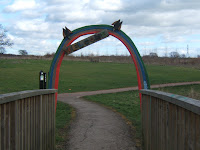 This section is the one that passes closest to home with the start and finish being just 20 minutes away by public transport. The weather was very warm (unusual for 2007) so I decided to leave early to avoid the heat. The route was very level following the Ingrebourne valley through Hornchurch Country park. Eventually you will be able to follow the Ingrebourne all the way to the Thames via Rainham creek and this will definitely improve this section, as the last part was all along roads.
This section is the one that passes closest to home with the start and finish being just 20 minutes away by public transport. The weather was very warm (unusual for 2007) so I decided to leave early to avoid the heat. The route was very level following the Ingrebourne valley through Hornchurch Country park. Eventually you will be able to follow the Ingrebourne all the way to the Thames via Rainham creek and this will definitely improve this section, as the last part was all along roads.Hornchurch Country Park was built on the site of RAF Hornchurch, a famous WW1 & WW2 fighter station. I used to visit regularly but sadly can’t anymore due to a height restriction.
 (Obviously I can get under the height barrier, but the van can’t.) There is quite an extensive area of countryside here with farmland and woodland on the other bank of the river.
(Obviously I can get under the height barrier, but the van can’t.) There is quite an extensive area of countryside here with farmland and woodland on the other bank of the river.After passing Tit Lake and Albyns farm house, a medieval manor house, it was a boring footslog to Rainham, where I got lost in Tescos looking for a toilet. Rainham has a cute little church, clock tower and Rainham Hall, a National Trust property I haven’t managed to visit. Not the most spectacular leg, but I’m certain this one will be the quickest to complete.
Section 23 Essentials
Section Map
Directions
Distance and Time: 4 miles 2hours 30 minutes
Walking Conditions: Almost completely level, tarmac or firm gravel paths, no stiles. This section is suitable for the less mobile and is accessible for pushchairs.













